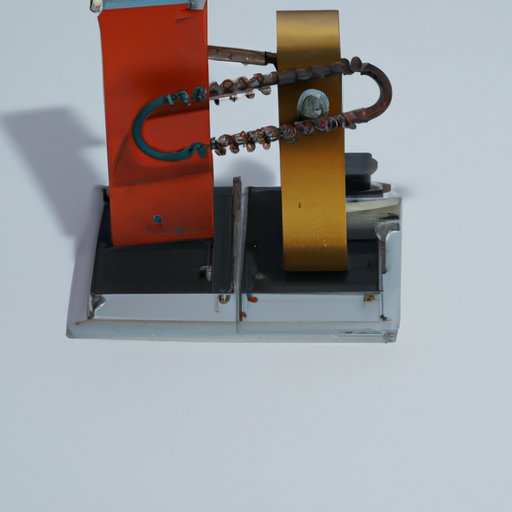Introduction
An electromagnet is a type of magnet that is created when electricity passes through a coil of wire. This creates a magnetic field around the coil, which can be used to attract or repel metal objects. In this article, we will explore the physics of electromagnets, how to build one, their different types and applications, as well as the history and development of the technology.

Explaining the Physics of Electromagnets
Before we can understand how an electromagnet works, it is important to first understand the basics of magnetism. Magnetism is the force of attraction or repulsion between two objects that have an electromagnetic charge. All magnets have two poles – a north pole and a south pole – and they are attracted to other magnets with opposite poles. When two magnets are brought together, the poles interact with each other and cause a force of attraction or repulsion.
An electromagnet is created when electricity is passed through a coil of wire. This creates a magnetic field around the coil, which can then be used to attract or repel metal objects. The strength of the magnetic field depends on the amount of electricity that is passed through the coil. For example, if more electricity is passed through the coil, then the magnetic field will be stronger. Conversely, if less electricity is passed through the coil, then the magnetic field will be weaker.
Electromagnets can be used for a variety of purposes, such as lifting heavy objects or activating switches. They are also commonly used in industrial settings, such as factories, where they can be used to move large pieces of metal or to activate machinery. They are also used in automotive applications, such as in electric cars where they can be used to power the motor.
A Step-by-Step Guide to Building an Electromagnet
If you’re interested in learning how to build an electromagnet, here is a step-by-step guide:
1. Gather the materials you’ll need, including a length of insulated copper wire, a battery, some iron filings and a piece of cardboard.
2. Wrap the copper wire around the cardboard several times, making sure that the ends of the wire meet up and that the wire is securely attached to the cardboard.
3. Connect the two ends of the wire to the terminals of the battery.
4. Sprinkle the iron filings over the cardboard and watch as the filings form a pattern around the wire, indicating the presence of a magnetic field.
5. Remove the battery and the iron filings from the cardboard and your electromagnet is complete!

Examining the Different Types of Electromagnets
There are several different types of electromagnets, each with its own unique properties. The most common types of electromagnets are permanent magnets, soft iron core magnets, coil magnets and variable field magnets.
Permanent magnets are made from a strong material such as steel or iron and are not affected by electricity. These types of magnets are often used in motors, generators and loudspeakers. Soft iron core magnets are made from a weaker material such as aluminum or brass and can be switched on and off using electricity. Coil magnets are made from a coil of wire wound around a ferrous core and are used for applications such as lifting heavy objects. Finally, variable field magnets are made from a coil of wire wound around an adjustable core, which allows the user to adjust the strength of the magnetic field.
Investigating the Applications of Electromagnets
Electromagnets have a wide range of applications in both industrial and domestic settings. In industrial settings, electromagnets are used for a variety of tasks, such as lifting heavy objects, sorting scrap metal, controlling valves and activating machinery. They are also used in automotive applications, such as in electric cars where they can be used to power the motor. In household appliances, electromagnets are used in things like refrigerators, washing machines and dishwashers.
In addition to these uses, electromagnets are also used in medical imaging and in research laboratories. For example, MRI scanners use powerful electromagnets to create a detailed image of the body and in research labs, they can be used to study the behavior of particles in a magnetic field.

A Look at the History and Development of Electromagnets
The history of electromagnets dates back to 1820 when Danish physicist Hans Christian Oersted discovered that electricity could create a magnetic field. Following this discovery, scientists began experimenting with different ways to create stronger and more powerful magnets. In the late 19th century, English scientist William Sturgeon invented the first electromagnet, which was made from a coil of wire wound around an iron core. Over the next few decades, scientists continued to refine and improve upon his invention and today, electromagnets are used in a variety of applications.
Looking to the future, scientists are continuing to develop new and improved methods of creating and controlling electromagnets. For example, researchers at Purdue University recently developed a new type of electromagnet that can switch on and off much faster than traditional electromagnets, which could have implications for medical imaging and other technologies.
Conclusion
Electromagnets are a powerful and versatile tool that can be used for a variety of purposes. By understanding the physics of magnetism and the different types of electromagnets, we can better appreciate the many applications of this technology. From industrial settings to household appliances, electromagnets are an integral part of our modern lives and will continue to play an important role in the future.
(Note: Is this article not meeting your expectations? Do you have knowledge or insights to share? Unlock new opportunities and expand your reach by joining our authors team. Click Registration to join us and share your expertise with our readers.)
